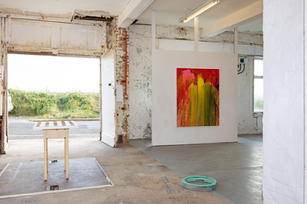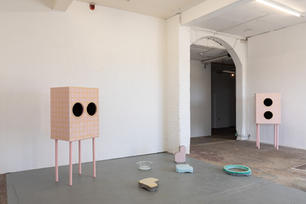
Electro Studios Project Space 4 - 5th September 12 - 5pm Opening: 3rd September 6 - 9pm
Oceanic Feelings
“Oceanic Feeling is a feeling of an indissoluble bond, of being one with the external world as a whole”
– Sigmund Freud, ‘Civilization and Its Discontents’ 1930.
Oceanic Feelings is an exhibition and collaboration between artists Becky Beasley with Beatrice Tailby Hardstaff, Clare Burnett, Leah Clements, and Sam Smith with Project Art Works, curated by Mariana Lemos. Our story begins with an invitation, a shared interest in washing machines, the general mechanics of things, how they work, how they move, how we move, time, light, circles, and of course, the sea.
This exhibition marks the end of Burnett’s residency at Electro Studios. The sculptor who is based in London and works with discarded mass-produced objects, spent her time on the Seaside Road making new works that respond to the exhibited ‘Untitled’ paintings by artist Sam Smith. Smith is based in Hastings and works with the support of Project Art Works – a collective of neurodiverse artists and activists based in Hastings, nominated for the Turner Prize this year.
For a long time, Burnett was aware of Smith’s interest in washing machines, and from this mutuality, she started to entwine their ways of working: learning from Smith to follow her intuition, his use of colour and the layering of repetitive movements that can be seen on the surfaces of Smiths’ paintings and in Burnett’s repetitive tiling. For Oceanic Feelings, Burnett took apart three washing machines. The works titled ‘Those Who Have Eyes to See', 'The Gyres', and ‘The Centre Cannot Hold', expose the insides of washing machines, now deconstructed, scattered and reimagined. As part of these pieces, we can find those circular holes and glass bowls that we are so used to looking into at home – like windows into underwater worlds — these round shapes are echoed throughout the exhibition.
A circle, a metaphor for the endless looping of time, repetition, the tide coming in and out on the beach, air filling our lungs and out again into the world — the natural rhythms of life. Embodied experience builds up a form of knowledge that challenges the mind and body divide. If we think of ourselves more similar to plants, we could understand our bodies as a whole fully receptive to stimulus, without a centralised nervous system feeding information to the brain. Perhaps some knowledge belongs to the skin, the muscles, the joints, the blood, the gut, and so on.
The ‘Natural Glaze Research Archive’ is a collaboration between Becky Beasley and Beatrice Tailby Hardstaff that makes accessible Beasley’s research and development of her own natural ceramic stoneware glaze, the ‘BB @ The Seaweed Shop’. Beasley’s research has materialised in the shape of small circular glaze test tiles – each telling the many small stories of her learning process. Beasley collects wood ash from Tommy’s Pizzeria, a local independent wood-fired pizzeria in St Leonards, and because the ash varies from batch to batch, she finds many hurdles that create restricted and interesting challenges along the process, which she carefully documents.
Tailby Hardstaff designed the presentation of the archive. In the display, she accentuates repetition: the repetition of the stamp references and the repetition in the glaze recipes; laid out against the flat white plane holding the narratives between glaze samples. Through their meticulous methods of categorising, archiving and displaying, this project aims to make sense of things. The archive functions as a working diary of the experimentations, including the failures, successes, questions and confusions, and as an educational resource. Not excluding mistakes and driven by experimentation, the glaze archive displays how knowledge is built from a place of unknowing, undoing and even queering.
The accumulation of repetitive actions is ever so present in Oceanic Feelings, it represents the passing of time and the mundane but also the mechanics of the world. In contrast, Leah Clements’ photographic work invokes a moment of stillness, a brief moment of transcendence from the gravity of the everyday. The photograph titled ’03:59pm’, captures a fleeting beam of sunlight, magically held in time and space by this image. Displayed as a slide projection, the photograph, in which an instant of ephemeral light is central, is re-translated back again through light, and this passing moment is suspended continuously.
Similarly, Clements’ ‘Dormance’ is a prism placed in an area where it holds a latent potential, dependent on the sun to create a beam of refracted light. Which may or may not happen during the length of the show, and if it does, it may or may not be seen by anyone. Like the concept of “oceanic feeling” Clements’ work marks the event of a sublime change. In these moments we feel grounded, impelled to acknowledge the constellation of feelings that makes the body whole, but also fluid, dispersed, multiplied – like water – part of the wider and wilder world.
Mariana Lemos
























